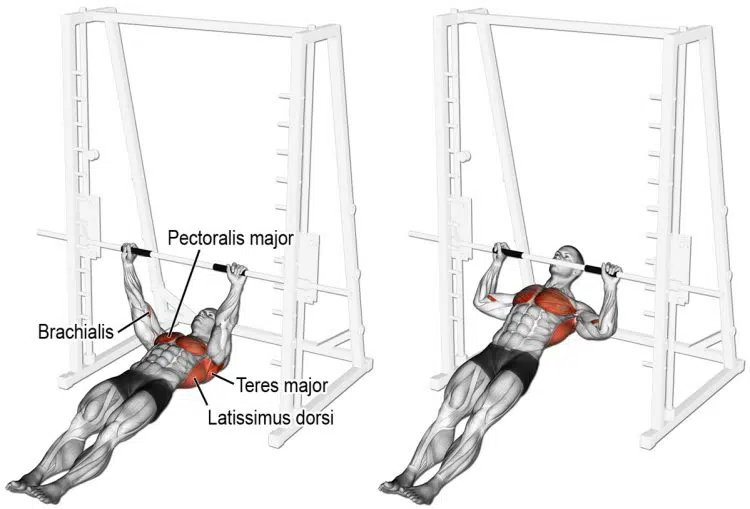Pull-Ups are, without a doubt, one of the most “badass” of the exercises. Unfortunately, they’re also really freakin’ hard!
Think about it: just a few of your muscles (Upper Back, Shoulders, Biceps, and Forearms) are doing all the work of pulling your entire body weight up from a hanging position. That takes a lot of strength—strength that many beginner resistance trainees don’t yet have.
But that’s where the Horizontal Row comes in handy! This exercise allows you to perform a Pull-Up-like exercise that develops all the “pull” muscles that you plan to one day make strong enough to knock out those Pull-Up reps with ease.
The Horizontal Row is an amazing movement for beginners, but even hardcore weight trainees can incorporate it into their weekly routines to target the upper body pull muscles in a new and highly effective way.
Below, we’re going to take a closer look at the Horizontal Row, examining the muscles it works, how to perform it correctly, what variations you can perform, and the benefits of risks of the exercise. We’ll even look at a few alternatives that will help you build greater pull strength to perform the Horizontal Row—and, ultimately, Pull-Ups—effectively.
Once you see how useful this movement is, you’ll definitely want to incorporate the Horizontal Row into your upper body workouts!
Level Up Your Fitness: Join our 💪 strong community in Fitness Volt Newsletter. Get daily inspiration, expert-backed workouts, nutrition tips, the latest in strength sports, and the support you need to reach your goals. Subscribe for free!
Horizontal Row Muscles Worked
The Horizontal Row—also known as the “Inverted Row”, the “Fat Man Row”, and the “Australian Pull-Up”—focuses on the upper back (latissimus dorsi) muscles, similar to the way a Pull-Up does.
However, your other back muscles also are engaged, including your trapezius, rhomboids, infraspinatus, erector spinae, and teres minor muscles.
Of course, in order to achieve sufficient pulling power, the shoulder muscles (particularly the posterior deltoid) and biceps are engaged. And, of course, don’t forget the forearm muscles, which are contracting the muscles in your fingers to grip the bar tightly.
But that’s not all! To maintain the proper stiff-bodied form required for the exercise, your abs, obliques, hamstrings, and glutes all work together to steady your core. The result extends far beyond just strengthening your Pull muscles—the exercise targets your trunk and pelvic muscles very effectively!
How to Perform the Horizontal Row
The Horizontal Row, like all “Pull” exercises, require proper form and controlled movement to execute correctly—and, most important of all, safely. Swinging, jerking, or as they say in CrossFit, “kipping” (cheating by using momentum in your body to facilitate the movement) can increase your risk of injury, particularly in your shoulders and elbows.
You’ll be far better off simply adjusting your angle to make the exercise easier, rather than risk joint injury by using incorrect form.
The Horizontal Row is a basic exercise that will be fairly simple to perform:
- Use either a Smith machine or rack a barbell on a Squat Rack. Set the bar to roughly the height of your stomach (to start out easy).
- Grip the barbell firmly in a pronated (Pull-Up) grip, with your palms facing away from your body.
- Bend your knees and walk your feet slowly forward beneath the bar until your arms are fully extended and you are hanging by your hands.
- Inhale, squeeze your core muscles and glutes tight, and pull upward to bring your face toward the bar.
- Stop just before your chest touches the bar. Squeeze your shoulder blades together at the top of the exercise to further engage the upper back muscles.
- Exhale on the eccentric phase of the exercise. Keeping your movements controlled, lower yourself back down until your arms are once more fully extended.
- Pause for a 1-count at the bottom of the exercise, then repeat.
Note: It’s most important to control the descent (eccentric phase) as you lower your body back down to its starting position. If you let the muscles relax too quickly and simply drop, you not only lose the hypertrophy-causing benefits of the eccentric phase, but also risk straining your elbows, shoulders, and possibly even your wrists.
Benefits of the Horizontal Row
What makes the Horizontal Row such a great exercise? There are a number of excellent reasons that you should be including this movement into your weekly training sessions:
Greater shoulder development
While most people focus on training their back and biceps (the more visible muscles), the shoulders often get far less attention than they deserve. Not only does this lead to decreased power in the critical shoulder muscles (which are engaged in every upper body movement), but could also cause muscular imbalances and joint instability.
The Horizontal Row targets the external rotators along with the posterior deltoids, helping to strengthen the muscles supporting your shoulder joint and encouraging better joint mobility. It also increases scapular retraction, encouraging smoother backward rotation of your scapula to increase shoulder joint stability.

Easily Adaptable
If you’re totally new to working out and don’t yet have serious Pull-Up strength, the Horizontal Row lets you work at a steeper angle to reduce the load on your arms. But as you grow stronger, you can decrease the angle to increase the amount of weight you’re rowing.
The Horizontal Row is an excellent precursor to Pull-Ups and rope climbing; it’ll strengthen all of your “Pull” muscles and bring you to a point where you can start incorporating more difficult pull exercises.
Greater Time Under Tension
The Horizontal Row increases the time under tension for your back, shoulders, biceps, and forearms, which in turn leads to accelerated strength development. You’re never “relaxing” through the entire range of motion, but your muscles are always engaged to pull up, lower your body to its original position, and hang suspended from the bar.
[Related: Time Under Tension – Does it Matter or Just a Myth?]
Work With Your Bodyweight
Bodyweight training is excellent because it develops “functional strength”, or the strength you’ll need as you go about your activities of daily life. Exercises like the Horizontal Row allow you to start using your bodyweight even if you’re not yet strong enough to do Pull-Ups or more advanced bodyweight movements.
Level Up Your Fitness: Join our 💪 strong community in Fitness Volt Newsletter. Get daily inspiration, expert-backed workouts, nutrition tips, the latest in strength sports, and the support you need to reach your goals. Subscribe for free!
It will help you develop greater coordination and muscle control, enabling smoother, easier movements unique to your specific body.
Better Core Development
Because of the position of your body during Horizontal Rows, your core muscles have to engage to keep you stable throughout the full set. This will lead to better activation of the abs, lower back, obliques, glutes, and even your hamstrings and thighs. You’ll find that performing exercises that require a stiff midline (like Horizontal Rows do) will increase your full-body strength and increase your stability and balance.
Risks of the Horizontal Row
As with any exercises, there are a few risks to be aware of:
Unstable Bar
If you’re working with a barbell racked on a Squat Rack, there is nothing stopping the bar from lifting and sliding off the rack. It’s important to keep your movements steady and controlled to avoid un-racking your bar—or simply use a Smith machine or TRX bands to reduce this risk.
Neck and Shoulder Pain
This is typically caused by the “cheating” movement of thrusting your head forward to try and reach the bar as you finish the pull. It’s imperative that you keep your head steady and in place while you pull. If you’re struggling to reach the bar, adjust your angle to decrease the load so you can perform the full set smoothly.
[Related: Fix a Stiff Neck and Avoid Shoulder Pain in The Gym]
Not Ideal for Back Pain Sufferers
Because your trunk muscles have to engage to keep your entire body rigid, there is a risk of aggravating existing back pain. Or, those recovering from back injuries may find that the constant lower back muscle engagement can trigger further injuries.
Horizontal Row Tips for Success
For those incorporating the Horizontal Row into their workouts, here are a few tips to help you maximize both the effectiveness and safety of this exercise:
- Raise or lower the bar as needed. If you’re struggling to finish a set, it’s better to raise the bar to decrease the load on your muscles rather than jerk or swing through the movement.
- Change up your grip as needed. If you feel strain on your wrists, switch between overhand (palms facing away from you) and underhand (palms facing toward you). The ideal grip is overhand, roughly shoulder width apart, but switch it up as needed to reduce wrist strain.
- Keep those core muscles tight! You want to keep your body fully stiff—it not only increases core engagement, but the solid platform encourages better focus on the upper back, shoulder, and biceps muscles.
Horizontal Row Variations
Give these variations on the Horizontal Row a try, and see how they make an already excellent movement even better!
TRX/Ring Rows
Using rings or TRX bands makes the Horizontal Row a bit harder, because you’re pulling on something that is freely moving, and thus your muscles have to engage to not only pull you up, but also maintain stability.
Explosive Horizontal Rows
Instead of using slow, controlled movements, rest at the bottom of the row (arms extended) then explode upward to pull your body to the bar with as much force as you can muster. Slowly lower yourself back to the original position, and repeat. This will help to develop explosive power in your Pull muscles.
Bodyweight Catch-Release Rows
This is another excellent exercise for developing explosive power. When you release your grip on the bar, it takes extra effort to catch and lower yourself safely. It’s a tiny variation on the standard Horizontal Row that can make a huge difference for your grip strength.
Feet Elevated Horizontal Row
Elevating your feet increases the challenge because it means you have to pull more of your bodyweight. Use a bench or a solid jump block as a stable platform.
Weighted Horizontal Row
Weighted Horizontal Row, this is done just like a regular Horizontal Row, but using a weight-filled backpack to increase the difficulty level.
Alternatives to the Horizontal Row
Looking for other highly effective exercises to develop your Pull strength apart from Horizontal Rows? Here are our top-recommended movements:
Assisted Pull-Ups
Even if you’re not yet strong enough to do proper Pull-Ups, you can still do the assisted variation. Use the Assisted Pull-Ups Machine if your gym has it. If not, run resistance bands over the top of your Pull-Up bar, then stand in the two loops at the end of the resistance bands to help you as you perform the exercise.
Seated Cable Rows
This exercise works the same muscles as the Horizontal Row, though in a slightly different plane of motion. With this movement, you pull the handle to your abdomen rather than pulling your face up toward a bar. This actually helps to simulate the core engagement necessary for Horizontal Rows.
Barbell Rows
This exercise is ideal for those who want to load up their “Pull” workout with the maximum amount of weight. The two-handed exercise is similar in nature to both Pull-Ups and Horizontal Rows, making it highly effective for developing the necessary strength in your upper back, posterior deltoids, biceps, and forearms.
Recommended Reading
- Best Cable Back Exercises
- Pull-Ups Vs. Chin-Ups – Which One is Right for You?
- Bench Press Vs Pull-Ups Vs Shoulder Press
- 21 Chin-Up and Pull-Up Variations
Horizontal Row – Wrapping Up
The Horizontal Row is, without a doubt, one of the single best exercises you can work into your Back Day routine. It’s ideal for those who haven’t yet mastered the Pull-Ups but who are looking to develop serious pull power using only their bodyweight.
You’ll love how versatile it is, how easily it can be adapted to your current strength level, and how, thanks to its full-body engagement, it will lead to greater muscle gains and functional fitness overall!
Interested in measuring your progress? Check out our strength standards for Bench Press, Pull Ups, Shoulder Press, and more.










